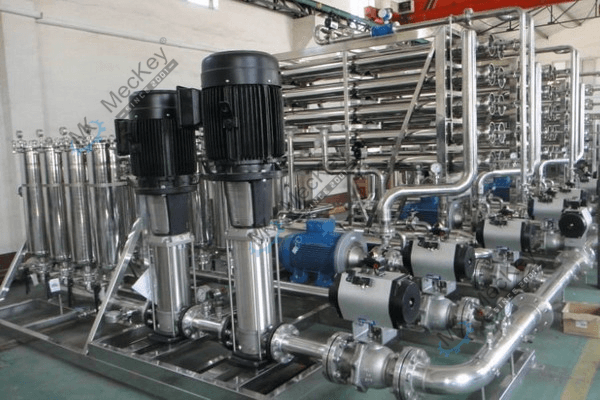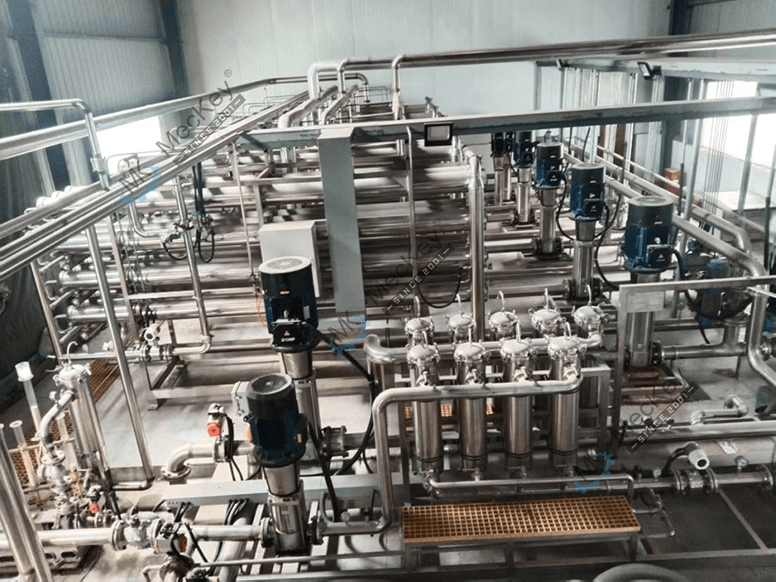Membrane Filtration Technology
Post on 2022-07-14


Fermentation liquid membrane separation and concentration technology
Solid-liquid separation of fermentation broth using microfiltration or ultrafiltration to remove macromolecules such as mycelia,proteins, viruses, pyrogens, etc., while small metabolites (including target products), salts and water are 100% permeated through microfiltration or ultrafiltration membranes. Secondary ultrafiltration of the first permeating fluid is carried out if necessary. Ultrafiltration technology can filter through to improve yield. Moreover, due to the filtration, the concentration ofthe target product in the ultrafiltration solution obtained is low. Therefore,the solvent and energy consumption used in the subsequent process can be saved.At the same time it can improve the yield and product quality, simplify the process, reduce the cost, with high-quality product.
Advantage of Fermentation liquid membrane separation and concentration process
1. Room temperature. The conditions are mild and without damage to components, especially suitable for heat sensitive substances.
2. Pure physical filtration, no phase change or qualitative change. Do not destroy the active components.
3. High filtration accuracy, uniform aperture distribution and can realize the purification and concentration of the effective components of fermentation liquid.
4. The system is simple to operate,short process, easy to clean and maintain.
5. Not only small in volume, fast in column loading time and small in resin consumption after the fermentation liquid is concentrated by filtration membrane, but also mycelium can be recycled, production efficiency improved, life of resin regeneration cycle of resin longered.
6. System cross-flow operation design, no need to add filter aid, will not introduce new impurities,completely solve the problem of pollution blockage.
7. System module design, filter material replacement is convenient, design online regeneration cleaning and sewage device, reduce labor intensity and production cost, improve production efficiency.
8. Automatic PLC control, low labor intensity, membrane filtration process in a closed container to achieve clean production.
9. Membrane filter element filling area is large, the system occupies a small footprint, convenient for technical improvement, expansion or new projects, effectively reducing investment costs and production costs
Glucose membrane separation technology
Microfiltration or ultrafiltration is used for solid-liquid separation of fermentation broth to remove macromolecules, such as maltose, maltose trisaccharide, etc., while glucose passes through microfiltration or ultrafiltration membrane. The content of glucose through liquid reaches 99.5%. The membrane filtration solution is used to produce VC grade sorbitol, and the residual solution is used to produce food grade and daily chemical grade sorbitol. The product quality is improved, the glucose crystallization process is omitted, and the cost is reduced.
Advantages of glucose membrane separation process
1. At room temperature, the conditions are mild and without damage to components, especially suitable for heat sensitive substances.
2. pure physical filtration, no phase change, qualitative change, do not destroy the active components.
3. high filtration accuracy, uniform aperture distribution, glucose purification can be realized.
4. the system is simple to operate,short process, easy to clean and maintain.
5. the system cross-flow operation design, no need to add filter aid, will not introduce new impurities,completely solve the problem of pollution blockage.
6. system modular design, filter material replacement is convenient, design online regeneration cleaning and sewage device, reduce labor intensity and production cost, improve production efficiency.
7. the system automatic PLC control,low labor intensity, membrane filtration process in a closed container, to achieve clean production.
8. Membrane filter element filling area is large, the system occupies a small footprint, convenient for technical improvement, expansion or new projects, effectively reducing investment costs and production costs